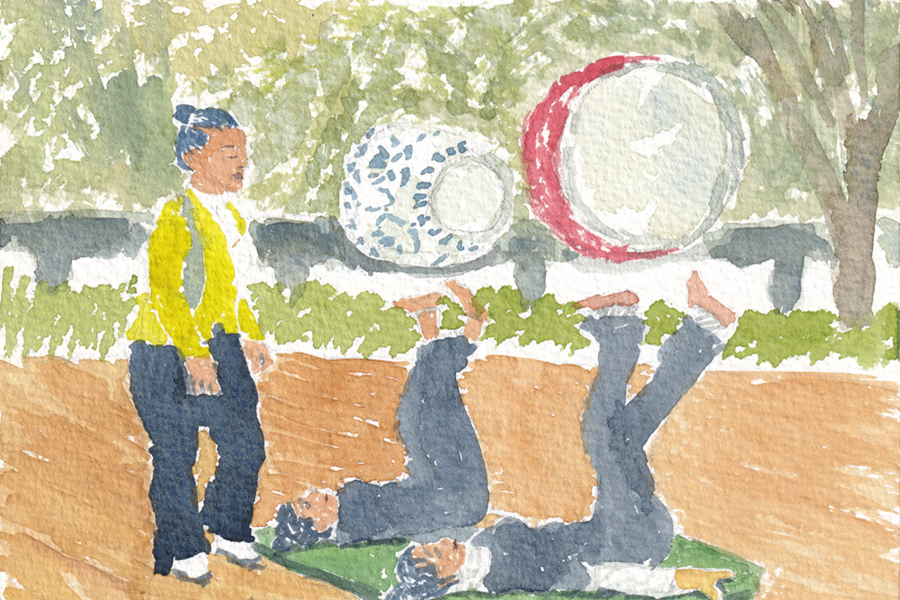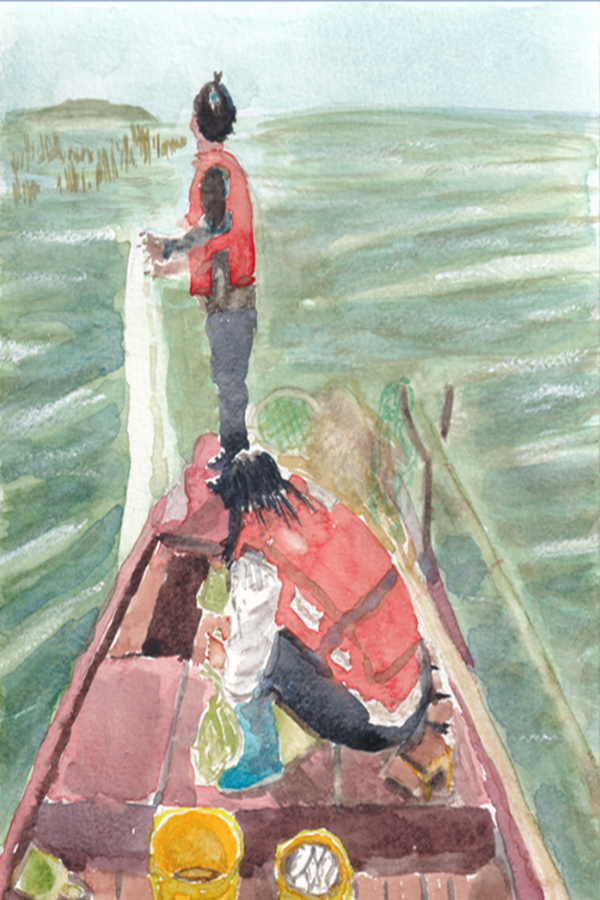A Journey of Discovery

On a leisure boat in Suzhou, Jiangsu Province, Andrew David Field beamed upon hearing Pingtan, a traditional local folk music, performed there while passing stone bridges and white-walled buildings along the waterways. The Grand Canal, a World Heritage site, passes through the city, giving it the nickname “the Venice of the East.”
“Way back in 1989, I took an overnight boat ride from Hangzhou (capital of Zhejiang Province) to Suzhou along part of the canal,” recalled the American researcher of Chinese history and host of the documentary The Grand Canal: China and Its Wondrous Waterway (2023). “This time, I tried to explore how the historical yet vibrant water system connects China’s past, present, and future.”
In the documentary co-produced by Jiangsu Broadcasting Corporation and National Geographic, Field led viewers through more than 20 cities and towns along the Grand Canal, presenting the waterway’s vitality to the world through stories of contemporary Chinese.
Bridging Regions
Field embarked on the “eye-opening and inspiring” project from Yangzhou, the birthplace of the Grand Canal, in Jiangsu Province. From there, he took two successive journeys spanning March to May this year. First, he headed south from Yangzhou along the canal, crossed the Yangtze River, passed through the vibrant Jiangnan region, and followed the canal to the sea at the port city of Ningbo, Zhejiang Province. Then, he headed north from Yangzhou along the canal through lakes, highlands, and plains to reach the mega-cities of Tianjin and Beijing.
“As a historian focusing on China studies, I had understood the basic history of the Grand Canal before the project and discovered new details during the journey,” said Field. “I think that made it more authentic because the whole purpose of the documentary was for me to learn about the canal and discover its particular features.”
“So, it was like a journey of discovery and hopefully it leads viewers on the same journey I enjoyed,” he added.
Contrasting most other cities on the itinerary, Yangzhou was new to Field. It sits at the junction of the Grand Canal and the Yangtze River, and for centuries the city’s wealth was earned from busy trade along the waterways. Field found another icon of Yangzhou’s culture as a canal city—Huaiyang cuisine—during his time spent with Zhang Hongjiao, a chef who operates his own restaurant in the city. According to Zhang, the canal defined water transportation in Yangzhou and spurred economic development for the city’s salt merchants, making Yangzhou very prosperous. The delicate local cuisine features light flavors, fine knife skills, and good temperature control combined with fresh ingredients, as per requirements passed down from ancient times. For example, Field was impressed by Crab Roe Soup Dumplings, which he nicknamed “a Chinese hamburger.” A special reed straw makes drinking the soup easier.

A still from the documentary featuring Andrew David Field tasting Crab Roe Soup Dumplings, a representative delicacy of Huaiyang cuisine, in Yangzhou, Jiangsu Province. (Photo courtesy of Jiangsu Broadcasting Corporation)
Amazing construction engineering and water management is another essential part of the story of the Grand Canal, which became quite clear during Field’s journey through the higher and drier Shandong Province. He was impressed by a remarkable piece of ancient engineering–Daicun Dam. Built in 1411 and still in operation today, it partially dams the Wen River and diverts the water towards the canal. According to Field, the dam was built in a “very clever” way to manage the flow of water, consisting of three sections with different heights. After its long climb, the canal reaches Dongping Lake, where Field found some impressive modern engineering, Baliwan Pumping Station, an important point on the South-to-North Water Diversion route. Water travels up the canal, drawn by the pumping station, to be deposited into Dongping Lake.
It’s clear that the Grand Canal still plays a role in China’s industry and economy. But in a twist, it’s now also being used to repair the effects of heavy industry via ecological restoration, another essential enrichment to the documentary. For many years, Xuzhou in Jiangsu Province has been an important hub for China’s coal industry thanks to its position on the canal. Now, the city is putting the canal to a new and very different use, exemplified by Pan’an Lake National Wetland Park, which struck Field while accompanied by Tian Yuan, chief planner of the park. According to Tian, the park, built on a former coal mine, used to be called Pan’an Village and lacked any water except for some rainwater and groundwater runoff. An ecological project launched in 2011 involved improving the water system and restoring vegetation. Specifically, the lake water comes from the Tuntou River, a tributary of the canal, and then reconnects with the canal through the Bulao River. Birds like magpies, sparrows, and woodpeckers and other animals such as hedgehogs, rabbits, and frogs frequent the park nowadays.

A still from the documentary featuring Andrew David Field enjoying a fish banquet with a local family in Dongping County, Shandong Province. (Photo courtesy of Jiangsu Broadcasting Corporation)
The Grand Canal facilitated all manner of trade, not only increasing wealth but enriching the culture and lifestyle of the regions it connected. In the town of Wuqiao, Hebei Province, Field came to see how acrobatics was revived. A performance named “Step on the Big Jar” took Field’s imagination to traveling acrobats of ancient times performing alongside the canal using pots, furniture, or whatever else was available. Today, local acrobats can showcase their incredible skills in a modern theater without trekking down the canal to find an audience.
“I guess my biggest takeaway is that the Grand Canal is not only a connecting line between China’s past and present, but also a key to understanding China as a country, its deep history and culture, its wonderful people and its energy and ambition,” noted Field in the epilogue of the documentary. “So I think it’s fair to say in a sense that China built the Grand Canal and then the Grand Canal shaped China.”
Human-Interest Stories
Flipping the sketchbook of Wu Liren in Hangzhou, Field got to know how the local painter had been inspired by the Grand Canal to paint its history for more than 40 years. Through working with lotus soil to learn brick-making from Zhao Qing’an in Linqing, Shandong Province, Field realized why the master mason had been maintaining the spirit of handmade bricks, which were used to rebuild Beijing during the Ming and Qing dynasties (1368-1911). By rowing with Yan Xian in Tongzhou District, Beijing, Field pictured a rowing coach ordering cargo boats from the south to enter the capital through “the Confluence of Five Rivers” in ancient times.
Meeting people whose life, work, and memories are so closely linked to the Grand Canal made him realize that the canal is not only an amazing piece of infrastructure, a conduit for trade and prosperity, and a historical wonder, but also a significant part of the lives and memories of so many people.
“I think by far, the most important thing about the film and what makes it authentic is the people we met during the journey,” said Field. “You can learn about the canal itself and its engineering from a book, but you wouldn’t know what it’s like to live and work on the canal every day, or navigate an artist’s obsession with it.”

An illustration of the acrobatic performance “Step on the Big Jar” in the town of Wuqiao, Hebei Province, created by Andrew David Field. (Photo courtesy of Andrew David Field)
The crew did everything they could to capture a kaleidoscope of scenes including panoramic drone footage and close-ups, while following the dynamic-oriented principles of director Richard Hughes. Wherever Field ventured during the filming, Hughes would seek out any opportunities to join the efforts of professionals to give viewers a richer experience.
Field also took up painting and sketching in a fusion of Chinese and Western styles to keep a record of his journey. Subjects include places he visited, people he encountered, architecture, bridges, and whatever else he deemed worthy of illustrating.
“For me, one analogy to China’s Grand Canal is the Erie Canal in the United States,” smiled Field. “It is a historic waterway that connects the Great Lakes with the Atlantic Ocean via the Hudson River in upstate New York, helping transform the American economy.”
“I hope to share my story of The Grand Canal: China and Its Wondrous Waterway with more people around the world,” he added.

An illustration of how locals fish on Dongping Lake, Shandong Province, created by Andrew David Field. (Photo courtesy of Andrew David Field)